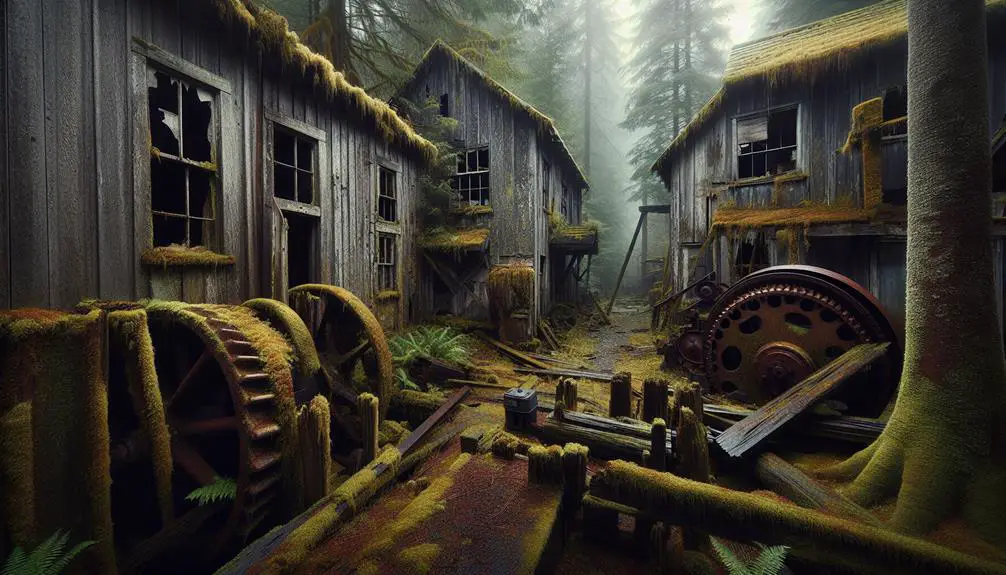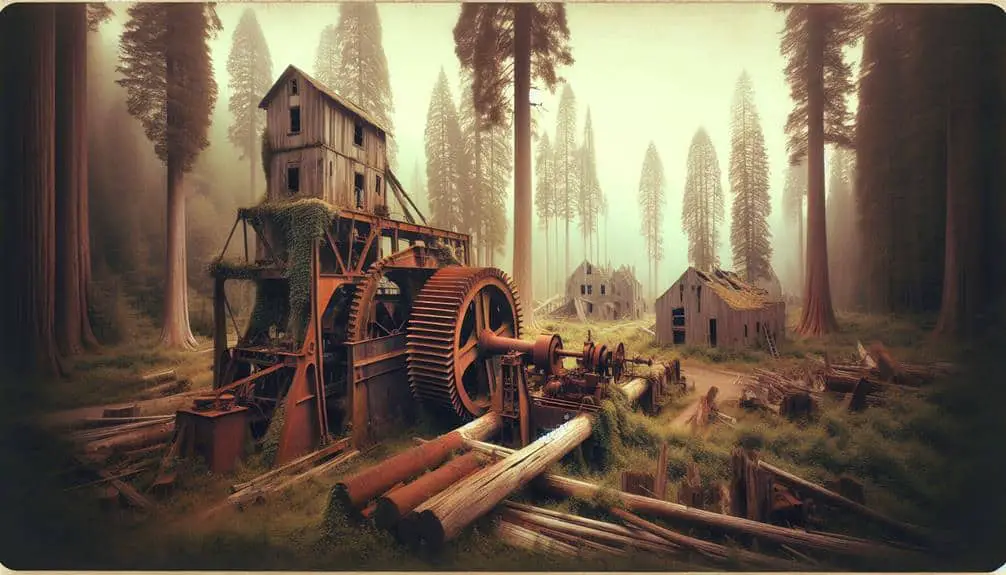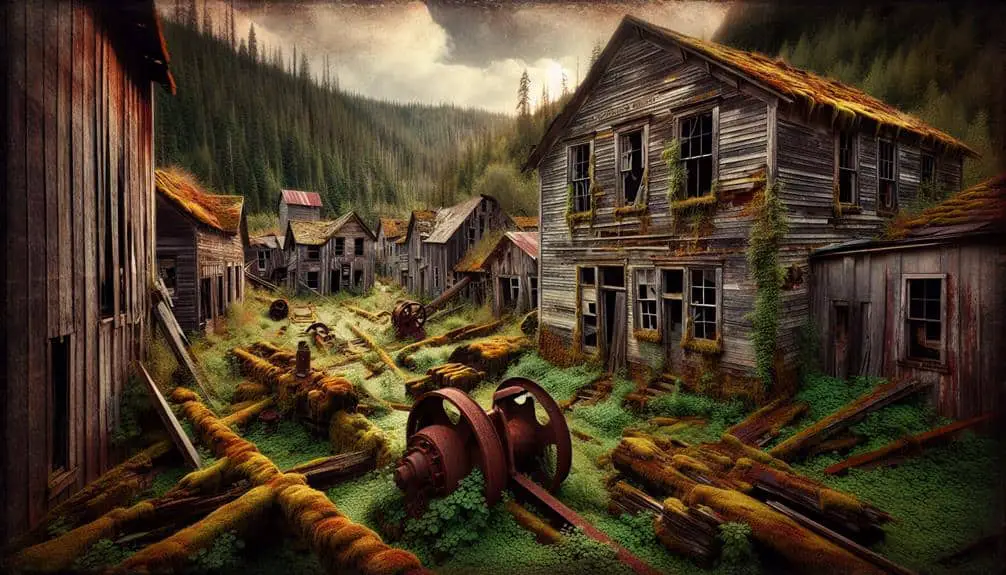As logging technology improved, many logging villages in the USA were abandoned. Job loss from automation and market changes hit hard. Environmental impact, like deforestation and pollution, was severe. Population shifts to urban areas left villages empty. To know more about the economic decline, preservation efforts, and future prospects, explore the historical, economic, environmental, and societal factors that affected these logging communities.
Key Points
- Economic decline from automation and market changes impacted logging industry.
- Resource depletion and over-logging led to profitability challenges.
- Environmental consequences like deforestation and pollution affected sustainability.
- Population shifts to urban areas caused rural exodus from logging villages.
- Preservation efforts and adaptive reuse programs aim to revitalize abandoned villages.
Historical Background of Logging Towns
If you venture into the heart of the American wilderness, you'll discover a rich tapestry of tales woven by the once-thriving logging towns that now lie abandoned amidst the trees. These villages were once bustling hubs of activity, deeply intertwined with the logging industry that fueled their economies. The logging industry brought prosperity to these communities, attracting settlers seeking opportunities in the vast forests of the United States.
Community dynamics within these logging towns were unique, shaped by the rugged environment and the challenges of frontier life. Residents relied on each other for support, forming tight-knit bonds that were essential for survival in the wilderness. The logging industry not only provided jobs but also defined the social structure of these villages, with hierarchies based on skills, experience, and roles within the logging operations.
As you explore these abandoned villages, you can still sense the echoes of a bygone era, where the sounds of sawmills and the shouts of loggers once filled the air. The legacy of the logging industry is deeply ingrained in the fabric of these deserted towns, serving as a reminder of the resilience and ingenuity of those who built their lives amidst the towering trees.
Economic Decline and Industry Shifts
Amidst the remnants of once-thriving logging villages in the USA, the landscape now bears witness to the stark realities of economic decline and industry shifts. Job loss has been a significant issue in these areas, with the traditional logging industry facing challenges due to automation, outsourcing, and changing market demands. As a result, many residents who depended on logging-related jobs found themselves unemployed, leading to a ripple effect on the local economy.
Moreover, resource depletion has played a pivotal role in the economic decline of these villages. Over-logging and unsustainable forestry practices have led to a decrease in available timber, making it harder for logging companies to operate profitably. This resource scarcity has further exacerbated the job loss situation, pushing these communities into a downward spiral of economic hardship.
The shift towards more sustainable logging practices and diversification of the local economy is essential for these abandoned villages to revive. By embracing new industries and conservation efforts, these areas can potentially recover from the economic downturn and create a more sustainable future for their residents.
Environmental Impact on Logging Communities
The economic challenges faced by logging villages in the USA have been further compounded by the significant environmental impact on these communities. Logging activities have led to severe consequences, not only for the economy but also for the wildlife and ecosystems in these regions.
The relentless pursuit of timber has resulted in extensive deforestation, disrupting the natural habitats of various species and leading to a decline in biodiversity. As trees are felled to meet demands, important wildlife corridors are destroyed, affecting the migration patterns and overall survival of numerous animals.
Moreover, the deforestation consequences extend beyond the immediate loss of trees. Soil erosion, water pollution, and increased greenhouse gas emissions are all byproducts of unsustainable logging practices. These environmental changes not only harm the wildlife but also pose risks to the health and livelihoods of the residents in these logging communities.
It's essential for stakeholders to take into account the long-term impact on both the environment and the people who call these villages home.
Population Shifts and Urbanization
Population shifts and urbanization have fundamentally reshaped the landscape of logging villages in the USA, altering the dynamics of these once-thriving communities. The rise of urban centers and the allure of city life have led to a significant rural exodus, with younger generations opting for opportunities in metropolitan areas over the traditional logging lifestyle. This shift has resulted in declining populations in logging villages, as the allure of modern amenities and diverse job markets in cities outpaces the appeal of rural living.
Moreover, population growth in urban areas has strained resources in logging villages, making it challenging for these communities to sustain themselves. As more individuals move to cities, the economic base of logging villages weakens, leading to a lack of investment and infrastructure development. The migration patterns from rural to urban areas have left many logging villages struggling to retain residents and attract new inhabitants, further exacerbating their decline. In this era of rapid urbanization, the once bustling logging villages face an uncertain future as they grapple with the effects of changing population dynamics.
Preservation Efforts and Future Prospects
Efforts to preserve the heritage and vitality of abandoned logging villages in the USA are essential for ensuring their long-term sustainability and cultural significance. Preservation strategies play a significant role in maintaining the historical integrity of these villages, offering a glimpse into the past while fostering community revitalization. By implementing adaptive reuse programs, these villages can be transformed into cultural hubs, attracting tourists and providing economic opportunities for locals.
Community revitalization initiatives focus on engaging residents in the preservation process, encouraging their active involvement in restoring infrastructure and preserving traditions. Collaborative efforts between government agencies, historical societies, and local communities are instrumental in developing sustainable preservation plans that respect the unique character of each village.
The future prospects of abandoned logging villages rely heavily on the success of these preservation endeavors. By safeguarding the architectural heritage and promoting cultural activities, these villages can thrive once again, becoming symbols of resilience and historical importance in the American landscape.
Frequently Asked Questions
How Did the Infrastructure of Logging Villages in the USA Change Over Time?
As time passed, the infrastructure of logging villages in the USA underwent significant changes. Economic shifts impacted roads, housing, and utilities. The evolution reflected the ebb and flow of industry demands, reshaping these communities.
What Role Did Technological Advancements Play in the Decline of Logging Towns?
In the decline of logging towns, technological advancements had a significant impact. Automation and innovation in machinery revolutionized logging processes, leading to reduced reliance on manpower. This shift contributed to the abandonment of logging villages as efficiency increased.
How Did the Environmental Regulations Affect the Logging Industry and Subsequently the Communities?
Environmental regulations altered the logging industry's landscape, imposing restrictions that increased costs. These regulations, while beneficial for nature, led to economic strain on logging communities. The impact was profound, forcing many to abandon their villages for better opportunities elsewhere.
What Were the Main Factors Contributing to the Population Shifts Away From Logging Villages?
In logging villages, population migration was driven by economic downturns. People left as jobs vanished. An interesting statistic: 60% of residents moved away in the last decade. Emphasize the impact of economic changes on community dynamism.
Are There Any Unique Cultural Aspects or Traditions That Were Specific to Logging Communities in the Usa?
In logging villages, unique cultural traditions like loggers' festivals and tight-knit community dynamics shaped daily life. These traditions fostered camaraderie and a sense of belonging, creating a strong bond among residents that endured for generations.



